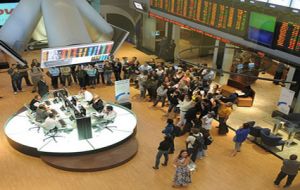MercoPress. South Atlantic News Agency
Rate hikes expected in Brazil and Chile as global commodity prices drive inflation
 Brazil is expected to increase interest rate by 50 bps in March
Brazil is expected to increase interest rate by 50 bps in March Global commodity prices continue to be the main driver of inflation in both Brazil and Chile, according to the latest Latin America update report from Capital Economics.
But while these effects may fade over the course of 2011, booming domestic demand means that core price pressures are likely to build at the same time and this may prompt some interest rate hikes.
However Capital Economics still expects currency concerns to ensure that they are gradual.
In Brazil, prices rose 0.8% on the month in January, which caused the annual rate of inflation to accelerate to a twenty-six month high of 6.0% y/y (up from 5.9% y/y in December). The outturn was in line with forecasts and leaves the headline rate far above the centre point of the central bank’s 4.5% ± 2 percentage points target range.
The breakdown shows that, once again, the food and energy components were the main drivers of higher inflation. Food prices rose by 1.2% on the month, while transport was strong too 1.6% m/m.
Admittedly there appear to have been some seasonal factors at play, but the bigger picture is that high global commodity prices have quickly passed through to the wider economy. Meanwhile Capital Economics calculations show that core inflation (excluding all food and energy components) only nudged up to 4% y/y (from 3.9% y/y in December), and remains below target.
Looking ahead, with Brazilian GDP growth being overwhelmingly driven by domestic demand, there is “a risk that core inflation” will begin to rise later this year. By contrast food and energy inflation will begin to fall over the second half of the year. Even if global commodity prices simply remain at the current high levels, the food and energy components should start falling in y/y terms over the coming months.
Inflation is expected to average 5% this year and around 4.5% next year.
Inflation is less of an immediate threat in Chile and even when prices rose 0.3% m/m in January, the annual rate of inflation fell to 2.7%, from 3.0% in December – below the central bank’s 3% target.
Like in Brazil, the breakdown shows that the main inflation pressures came from food and energy.
Seasonal factors meant that food prices actually dropped 0.8% m/m, but the annual rate of food inflation was 5.5%. At the same time, fuel inflation accelerated to 16.1% (from 13.0%) on the back of rising global energy prices. By contrast, core inflation fell to 2.0%, from 2.5%.
Nevertheless inflation in Chile is expected to rise over the course of this year, but food and energy inflation should fall back later this year. More importantly, with capacity pressures building in the economy, core inflation could begin to rise later this year.
In the end, Capital Economics expects inflation to average around 3.5% this year and next.
Regarding currency concerns the policy response in the two countries considered is not straight forward.
In Brazil interest rates are expected to be hiked by 50bps in March, but monetary policy thereafter is dependent on the size of any fiscal tightening which should be announced some time this week.
In Chile, the Central bank’s program of foreign exchange purchases is due to expire this week and, with copper prices topping 10,000 US dollars per metric ton, it may be extended.
That may keep rates on hold at 3.25% this month, before hikes towards 5% resume.




Top Comments
Disclaimer & comment rulesCommenting for this story is now closed.
If you have a Facebook account, become a fan and comment on our Facebook Page!